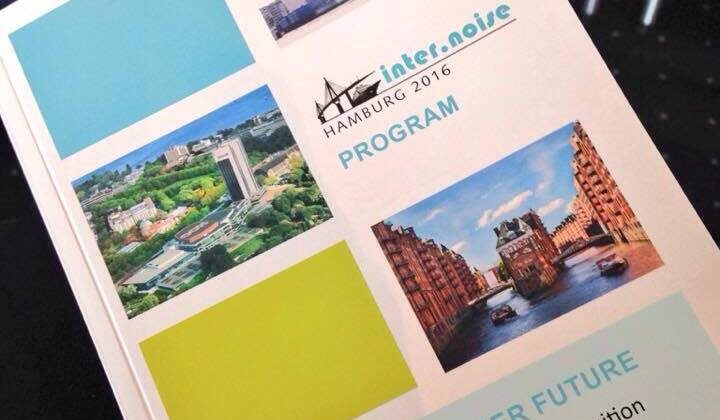
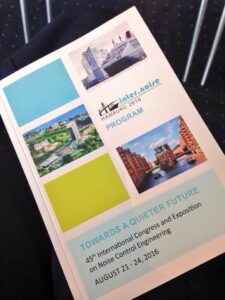
What you missed if you only attended the room acoustics sessions
We understand that like us, you guys loved the room acoustics sessions at INTER-noise in Hamburg. You were frantically running in between sessions so you wouldn’t miss a thing about sound scattering, psychoacoustics, standards, phone booths and so on. We TOTALLY get it. But don’t despair, Acoustic Bulletin’s got your back!
We’ve put together a list of other (almost as) interesting presentations from the massive program:
Gender differences in optimal listening levels and loudness perception – presented by Mariko Hamamura, Tokyo University of Technology
Gender differences never cease to fascinate. In this presentation, attendees learnt that males and females have different ‘optimal listening levels’ (according to the study, males optimal listening level is 6.6 dB higher than females) and corresponding ‘loudness perception’. Dudes seem to like it loud, or at least louder than the dudettes.
However interestingly, Hamamura also stated, based on her findings, that “the differences in loudness judgments may actually reflect differences in the use of verbal expression rather than differences in perception of intensity.” So maybe dudes don’t really prefer it louder after all, maybe it’s just that the genders weigh the words differently?
Read the full paper in Acoustical Science and Technology.
Soundscapes in historic settings – A case study from ancient Greece – presented by Pamela Jordan, TU Berlin
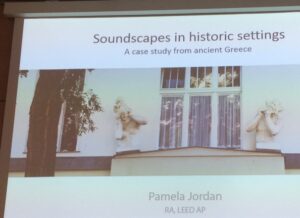 Imagine that you’re an architect working on an archaeological site in Greece. You try to figure out why the ruins are placed the way they are. You see no pattern – you try to figure out what the plan was – and then ‘boom’ it strikes you: What if the site was built the way it was because of the soundscape?
Imagine that you’re an architect working on an archaeological site in Greece. You try to figure out why the ruins are placed the way they are. You see no pattern – you try to figure out what the plan was – and then ‘boom’ it strikes you: What if the site was built the way it was because of the soundscape?
It’s commonly known that ancient amphitheatres are built to secure optimum ‘room’ acoustics but previous studies have not considered the soundscape itself to be an element of history or historic value.
Pamela Jordan gave an inspiring speech about the findings at Mt. Lykaion and talked us through how the historic soundscape concept served as the starting point for fundamental questions about how the site may have functioned in antiquity.
Evaluation of teeth grinding sounds during sleep – presented by Tomomi Yamada
Our editor Colin was brave enough to go to this presentation about how we perceive teeth grinding (bruxism) and dental drills. He reports that Yamada found that when both sounds were heard at similar sound levels, his subjects perceived teeth grinding as clamorous (loud and confused noise), loud and powerful. The drill was more shrill, harsh, sharp, tense and metallic.
Which do you find worse?
Yamada’s subjects indicate that most of you probably think the teeth grinding is more unpleasant, disliked and unpleasing.
If you suffer from teeth grinding or have to listen to teeth grinding (bruxism), here are some useful steps from the NHS UK to reduce the negative effects….
Unpleasant #dental #sounds compared at #Internoise2016 & we had to endure the soundfiles #howtocleararoom pic.twitter.com/JZCV7b87dP
— Colin Campbell (@EDU_Colin) August 23, 2016
Tranquillity trails – Design for city and town – presented by Gregory Watts, University of Bradford
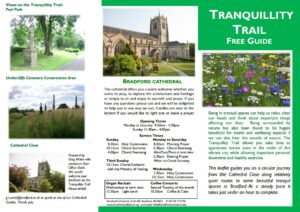
Did you know that there actually is a way to calculate tranquillity? Greg Watts and his colleagues have developed a method to predict tranquillity rates based on the man-made noise in the soundscape + natural elements in the visual scene.
Watts presented two different ‘Tranquillity Trails’ defined as “walking routes that have been designed to allow space for residents and visitors to reflect and recover from stress in urban areas while receiving the benefits of healthy exercise”. Some of his conclusions were that it is more challenging to achieve consistently high tranquillity rates in large urban areas due to heavily trafficked roads that are difficult to avoid. But on the upside, that the rates can be improved by extending the time spent in areas that rated high.
(Would be interesting to learn more about how this applies to indoor environments!)
Read more about Watts research.
Pregnancy and childhood exposure to residential traffic noise and overweight at 7 years of age – presented by Jeppe Christensen, Danish Cancer Society Research Centre
WHO calls childhood obesity a global problem and “one of the most serious public health challenges of the 21st century”. So it was no wonder the room was full when Jeppe Christensen presented a study in which he and his colleagues found “there may be small associations between residential exposure to traffic noise during childhood and risk of childhood obesity”.
Our editor Mai-Britt has written a Pulse post about another study conducted by the Danish Cancer Society Research Centre relating to traffic noise and an increased risk of breast cancer and non-Hodgkins lymphoma. Find out what paradox that study made her think of.
If you have any questions about INTER-noise 2016, feel free to contact one of our editors that attended the conference:
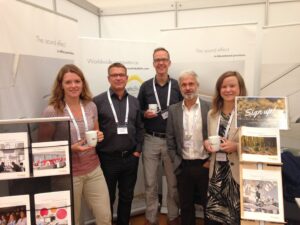
Mai-Britt Beldam – Healthcare environments specialist
Colin Campbell – Educational environments specialist
Frans Davidsson – Workspaces specialist
Pauli Pallaskorpi – Finnish educational environments specialist
Maria Quinn – Swedish healthcare environments specialist
Jonas Christensson – Swedish educational environments specialist

